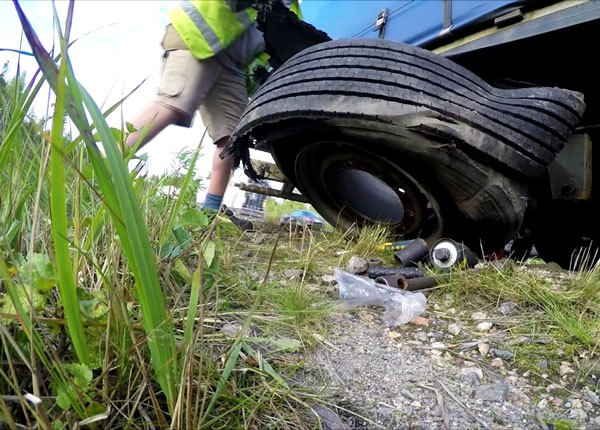
Handling A Tire Blowout: Common Causes, Warning Signals & What To Do
Updated Dec. 29, 2020Tire blowouts are incredibly dangerous as they affect handling and can make you lose control of your vehicle. At best they are a serious inconvenience; at worst, they can cause devastating accidents. Blowouts can be avoided by making sure your tires are safe and in good condition. Tire safety depends on maintaining the correct pressure, keeping within vehicle and tire load limits, avoiding hazards and regularly checking tires for damage.
Well-maintained tires will also maximize vehicle handling, fuel efficiency and overall vehicle safety. Treating them carelessly would be a mistake.
Tips for handling a tire blowout
Often, the best way to handle a tire blowout is to take no action and allow the car to stop itself. If you can keep your vehicle safely in its lane, the friction between the blown tire and the road should slow it significantly without you having to do anything. Ideally, you should be traveling at 30mph or slower before attempting to steer the vehicle to the roadside. The slower you are traveling, the better your chances of maintaining control.
If one of your tires blows out, follow these steps:
- 1

Try not to panic.
The tire will make a loud noise. - 2

Hold the steering wheel firmly and steer straight ahead.
Do not try to turn the wheel. - 3

Ease off the accelerator slowly.
Do not apply the brakes. - 4

Steer the car off to the side of the road.
Allow it to come to a complete stop. - 5

Only apply the brakes when the car has almost stopped.
- 6

Some experts recommend a gentle press on the accelerator when a tire blows, before allowing the vehicle to slow. The drag caused by your blown tire will prevent the car from going too much faster and pressing the accelerator can help you regain control if the blowout has caused you to swerve or fishtail.
Front-tire vs rear-tire blowouts
What happens to your car when a tire blows out depends largely on which tire is lost. Rear-tire blowouts are usually more disruptive and dangerous than front-tire blowouts, as drivers have no control over the rear end of the vehicle. Front-tire blowouts are still dangerous but generally easier to manage, as you should be able to steer to counteract the force of the blowout. Of course, your steering control will be limited if a front-tire has blown. When a rear tire blows out it can throw the car can fishtail. If this happens, there will be very little the driver can do to bring it back under control.
Causes of tire failure
When tires are properly maintained, your vehicle’s steering, traction, ability to stop and load-carrying capacity will all be optimized. Underinflated tires and overloaded vehicles are a recipe for disaster. This combination is one of the most common causes of flat tires, tread separation and tire blowout. Other causes of tire failure include:
- Overinflated tires. Your tires will heat up as you drive; this will cause the air they contain to expand. If the tire is already overinflated, the increase in temperature could result in a rupture.
- Old tires. Tires are designed to operate for a set number of miles. Once you go over that amount you are driving on borrowed time. Always replace your tires with the regularity recommended by the manufacturer.
- Extremely hot weather. Unusually hot conditions can add to the heat caused by friction between the tire and the roadway. Overheated tires can easily blowout. Avoid driving in extremely hot weather, if possible.
Correct tire pressure
Maintaining the correct tire pressure is one of the best ways to avoid a catastrophic tire failure. Your vehicle owner’s manual will tell you the pounds of pressure per square inch (PSI) that your tires require. The figure given represents the ideal pressure when the tire is cold, i.e. when it has not been driven on in at least three hours.
Tires get warmer as you drive on them, which causes the air inside them to expand and the pressure to increase. If you want to check your tire pressure and get an accurate reading, be sure to wait until your tires have cooled down.
 Most of the newer vehicles are equipped with a Tire Pressure Monitoring System that alerts the driver if tire pressure is too low and could result in a tire blowout.
Most of the newer vehicles are equipped with a Tire Pressure Monitoring System that alerts the driver if tire pressure is too low and could result in a tire blowout. Tread separation
Tread separation occurs when tire tread separates from the tire’s body. This could be the result of a manufacturing defect, though it is more commonly caused by:
- Underinflated tires. This could put additional pressure on the tire’s sidewalls and cause separation.
- Careless driving. Hitting holes in the pavement and other road defects at high-speed can result in tread separation.
- Poor repairs. A tire that has been poorly patched or plugged will be more susceptible to tread separation.
- Old or worn tires.
Drivers may notice a slight vibration when driving on the brink of tread separation. A visual check may reveal bumps or “blisters” forming on the tire. Separated tires are ticking time-bombs which significantly increase the risk of blowouts and accidents.
Serious cases of tread separation can be more dangerous than a blowout. If the section of the separated tread is long enough, it could tear through the passenger compartment or take out your rear windows. Plus, you will not have the advantage of the friction caused by a blown tire slowing the vehicle down. Always be sure to get your tires replaced at the first indication of tread separation.




